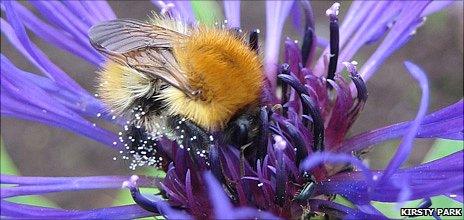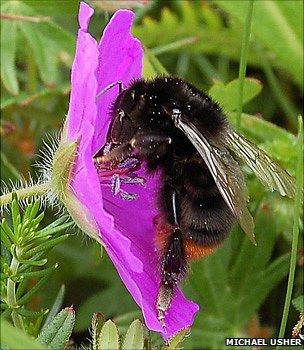Bumbles make beeline for gardens, study suggests
- Published

Bee numbers have been declining since the late 1960s, studies show
Gardens are able to sustain a greater number of bumblebee nests than farmed land, a study involving genetic analysis and modelling has suggested.
DNA samples were taken from two species by UK researchers in order to build up a picture of nest density and how land use affects the creatures.
Previous studies have shown that bumblebee numbers are declining in western Europe, Asia and North America.
The findings have been published in the Journal of Applied Ecology, external.
The team said that the importance of gardens tied in with the findings of earlier studies, which suggested the habitats provided a stronghold for the creatures "in an otherwise impoverished agricultural environment".

They added: "Our data suggests that the positive influence of gardens on bumblebee populations can spill over at least 1km into surrounding farmland."
Lead author Dave Goulson, head of the University of Stirling's School of Biological and Environmental Science, explained the reason for the study: "If you are a conservation biologist, you want to know how many animals you have got left and whether they are increasing or decreasing."
"Yet bumblebees are a bit odd because they are social insects, so you could go out into a meadow and count the number of bees you saw.
"But that would not really give you an idea on the population size because it could be that the bees you saw were worker bees, which where sterile, and would never have any offspring of their own.
"So what you need to do is to count nests, because within each nest is basically one single, female breeding bee - the queen. From a population biologist's perspective, the population size is the number of nests."
Professor Goulson explained that the nests were very hard to find: "You can walk through a meadow and not see any but you know they must be there.
"As a result, we have ended up with this rather elaborate way of counting the nest by catching the workers and DNA fingerprinting them, allowing you to work out which ones are sisters (all the workers from one nest are deemed sisters, as they are all offspring from the queen).
"Counting the sisterhoods gives you an idea of how many nests you have within the bee-flying range of where you are standing."
Tongues and toes
The team gathered DNA information on two of the UK's six most widespread species: the common carder bumblebee (Bombus pascuorum) and the red-tailed bumblebee (Bombus lapidarius).
"One of the things that distinguish bumblebees are the length of their tongues and this determines what plants and crops they visit," Professor Goulson told BBC News.
"What we wanted to do was include two contrasting species because it was important from a conservation point of view that we try and preserve examples of each."
Professor Goulson said that the common carder bumblebee was one of the longer tongued species, while the red-tailed bumblebee is relatively short-tongued.
In order to gather to collect a "DNA fingerprint" from each of the bees, the team effectively snipped off a toe.
"Basically, you take the last tarsal segment from a leg - the middle one ideally," Professor Goulson said.
"Essentially you take this tiny bit, barely visible to the naked eye, and with modern technology it is remarkably easy to amplify the DNA."
He added that the data gathered from more than 2,700 specimens allowed them to attempt to answer the question of what factors affected bumblebee nest survival, which - until now - was unknown.
"If you go out in the spring, you will see a lot of big, fat bumblebee queens flying around and each one of those will try to start a nest," Professor Goulson observed.
"It is clear that the vast majority of them will not succeed. Our estimate of how many nests there are at the end of the season are much, much lower than how many queens start off.
"What we were trying to do was quantify how the number of nests changed at various points in the landscape from May to the end of July, and seeing if we could explain why nests did better in some places compared with others - we looked at what the landscape contained and what could make bumblebee nests more or less likely to survive."
The team found that even quite a small amount of gardens seemed to be having a big, positive impact on the density of bumblebee nests.
"Most of the sites were farmlands, but even just a few percent of gardens in the surrounding landscape seemed to have a positive effect up to a kilometre away," said Professor Goulson.
"We've always suspected that gardens were good for bumblebees, but in some ways it is quite disturbing because while it is good news for gardeners, the flip side is that farmland is pretty rubbish for bumblebees these days.
"It has become rather odd that some bumblebee species now seem to be much more abundant in suburban areas than in 'green' countryside."
Lack of flowers
One of the overarching goals of food policy in post-war Britain was to grow as much food as possible on British soil, at an affordable price for consumers.
Yet decades of intensive farming took their toll on the countryside and the habitat needed to support a diverse range of flora and fauna.
Professor Goulson said the study's findings offer a "glimmer of an answer", but it was not practical to suggest that people should put gardens in the arable land across the world.
"But there the one area of farmland that was very good (for bumblebee nest density) was an area that had a clover ley on it," he added.
Clover leys were used in rotation systems to improve soil nutrition levels, but the system fell out of favour in the mid-20th Century as cheaper synthetic substitutes became available.
Professor Goulson, who is also a director of the Bumblebee Conservation Trust, explained: "Clover is a favourite food for bees, so one way forward - from my perspective - would be if farmers did start using crop rotation systems on a landscape scale."
"In terms of long-term sustainability, it is a very attractive option environmentally if it can be made to work economically for farmers.
"Bumblebees and other bees are the main pollinators of lots of wild flowers and quite a lot of our crops - the fruit and veg you might buy from a supermarket would not be there is it were not for bumblebees.
"There is pretty good evidence that bees are declining, so we need to understand why and where they are declining, so we need to find out more about them so then we can stop them declining even more, and even boost their numbers."
- Published7 September 2010
- Published22 June 2010
- Published29 May 2010
- Published12 October 2010